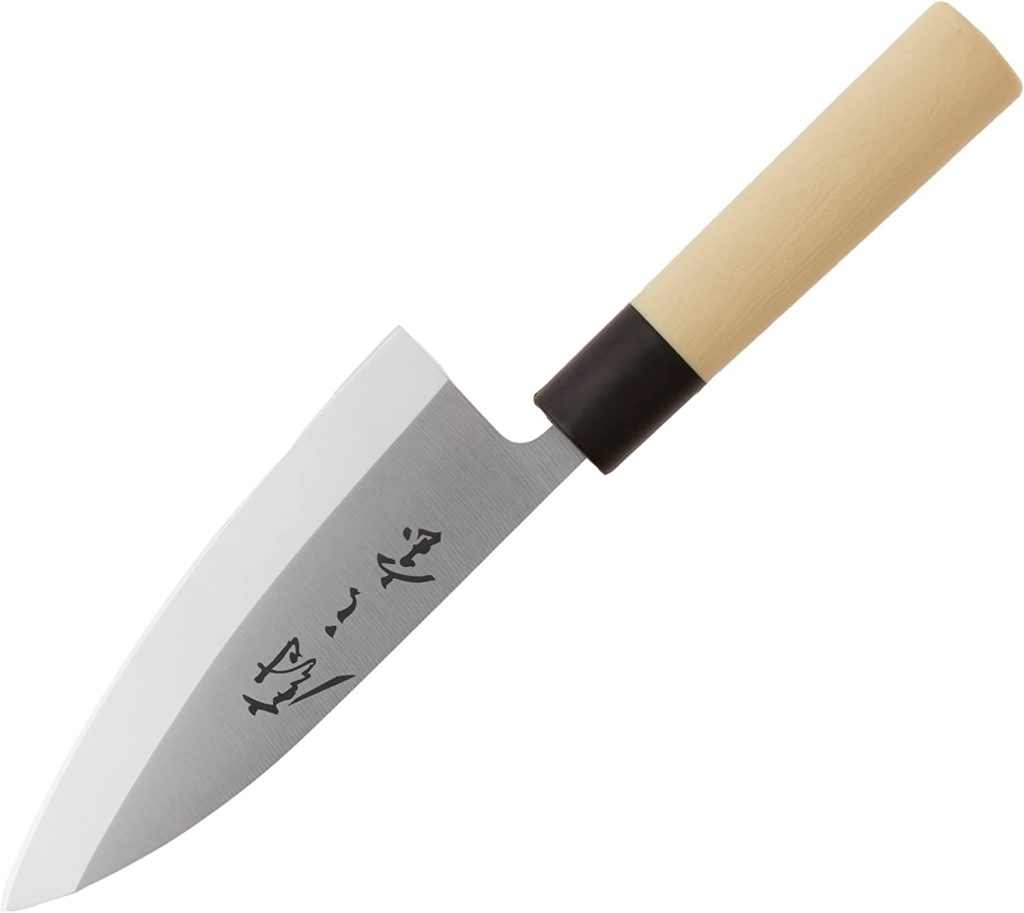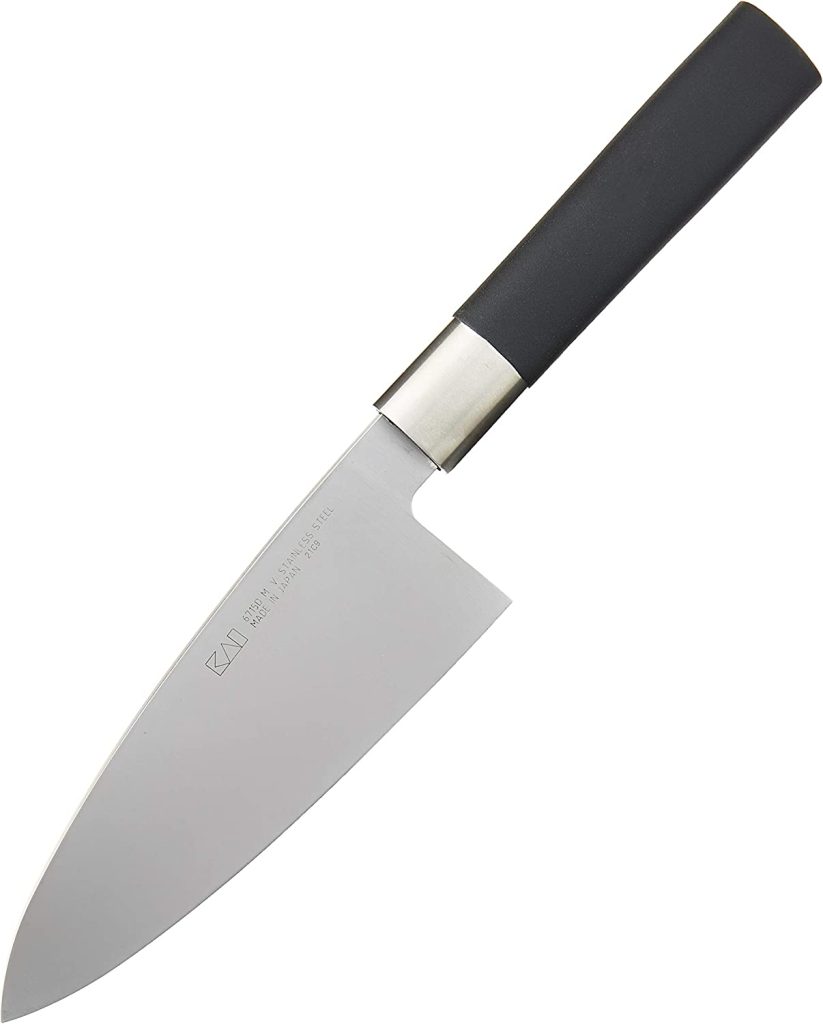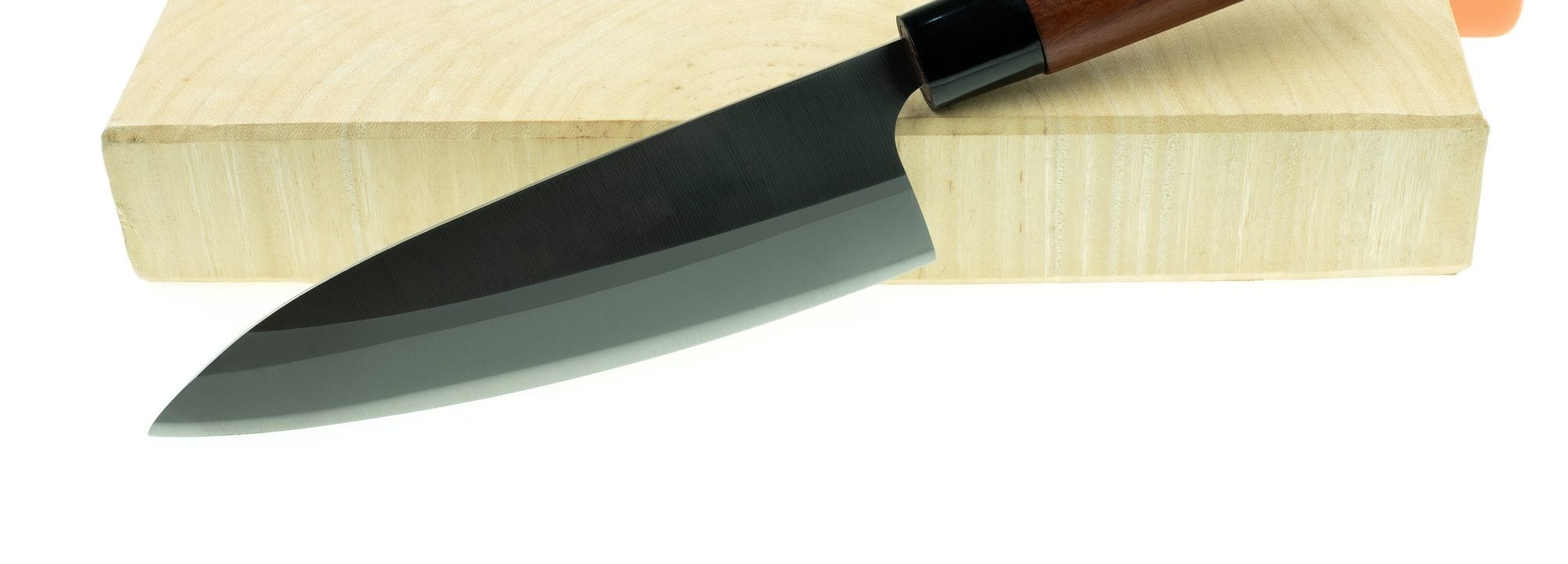Every Japanese restaurant will have a traditional Deba knife readily available because of its capabilities in cutting fish and other similar ingredients. This is a pointed blade used mainly for fresh fish and poultry because of the precise deep cuts and controls the knife offers users. Of course, personal preferences and the unique needs of a kitchen may vary. That is why we also put together a fillet knife buying guide as an alternative. If you want to start with Deba blades, we suggest our top pick for 2023 – the Kai Seki Magoroku Kinju ST Japanese Deba Knife. Read on to learn more about our best choices.
Top 5 Deba Knives
  Editor's Choice Editor's Choice | ||||
 | ||||
 | Check Price | |||
 | Check Price | |||
 | Check Price |
1. Kai Seki Magoroku Kinju ST Japanese Deba Knife – Editor’s Choice
Of all of the exquisite Deba knives, we were able to review and study, this is the top choice because of the balance between exceptional features, price, and user reviews.
Kai Seki Magoroku Kinju ST Japanese Deba Knife Specifications
About the knife
This is a traditional and simply designed Deba knife perfect for a wide range of applications. While it was created for fish, you will find the sharp edging and pointed tip perfect for working with birds of all kinds as well. There is not a reliable bolster like with most Western-designed knives, but that is to your advantage as there are traditional grips that will do the trick just as well. This is an excellent price point for a knife that balances out the primary features desired in a quality Deba knife.
Maintenance and Cleaning
One of the major benefits of a Kai-made blade is you get a lifetime of free sharpening. That is how confident the manufacturer is in the capability of the edge to hold its angle. Do not place this in a dishwasher. Stick to hand washing and drying with the blade’s occasional oiling to ensure its integrity.
Pros:
- Exceptional price point for such a versatile blade with fish and poultry.
- Beautiful simple construction with a sharp edge.
- Easy to maintain.
Cons:
- Not flexible, which may be hard to use for Western chefs.
- No bolster, so you have to use different grips.
- Extremely sharp edge.
2. Mercer Culinary Asian Collection Deba Knife
An exceptionally well-made Deba knife with a bit longer breaks between the handle and the tang, leaving room for hard-shelled ingredients.
Mercer Culinary Asian Collection Deba Knife Specifications
About the knife
We immediately noticed the difference in weight and size between the Mercer-made Deba blade and others on our list. This is a much lighter knife, meaning it takes a bit more dexterity and force to make cuts, even with the single bevel traditional edge to a Deba knife. However, because it is stamped, you get a much lower price and a premium handle quality that ensures excellent control at home, making a seafood dish just as much in a professional setting with sushi.
Maintenance and Cleaning
Never place it in the dishwasher. Only use hand drying and washing. If sharpening, try to maintain the single bevel cutting feature.
Pros:
- Excellent price point.
- Easy grip from a D-shaped handle
- Nice gap between the tang and handle
Cons:
- Lighter weight requires more effort
- Does not come with a manufacturer sharpening service
- German-made steel in a Japanese style
3. Kai Wasabi Deba Knife
You get a bit more depth and control with this blade compared to our other Kai choice and a wear-resistant blade for working with frequent water-related ingredients.
Kai Wasabi Deba Knife Specifications
About the knife
This is the second Kai-made blade on our list of the best Deba knives because they make such high-quality products. In this case, you do not get the same features as our top choice because the blade is stamped and has a bit softer materials. However, the comfortable handle allows for just as much flexibility with various seafood cuts, especially with larger fish pieces. This is one of those “must-have” blades for a kitchen that frequently works with fresh seafood for multiple meals.
Maintenance and Cleaning
Even though this is a stamped blade, it should not go into your dishwasher. Regular exposure to hot jets can warp the materials, and it is incredibly sharp for pulling out at the end. Carefully hand-wash and dry before storing safely.
Pros:
- Great flexibility and maneuverability
- Comfortable grip and sharp edge
- Traditional attractive design
Cons:
- Stamped instead of forged
- No bolster for Western grips
- Slightly skinnier than other Deba knives
4. Global G-7-Inch, 18cm Oriental Deba Knife
A bit more unique of a Deba knife design with exceptional edge sharpness and easy-to-work-with grip for frequently wet ingredients.
Global G-7-Inch, 18cm Oriental Deba Knife Specifications
About the knife
There are two main advantages to working with the Global Deba knife on our list. The first is that you get a single piece of solid metal. The entire blade is created without a break between the tang and the handle. It is all one piece. The other advantage is the handle. While it is not the most comfortable material and probably not the best for largest-handed chefs, it does offer that dimpled material that ensures your grip when working with so many seafood ingredients. That is why we suggest this for butchering more than precise work. Probably a good blade if you receive your components from a large market or frequently fish.
Maintenance and Cleaning
The single metal material makes this a bit easier to rust or damage in a dishwasher. Only use hand dying and washing techniques before storing the blade away.
Pros:
- A single piece of metal.
- Great grip for larger fish.
- Easy to maintain.
Cons:
- Not meant for larger hands.
- Better for large fish compared to precise cuts.
- A little on the pricier side.
5. Kai Shun Pro Sho Deba VG-0003
We wanted to fit in one more Deba blade with a stunning design and a bit of a bolster for hybrid Western – Asian chefs.

Kai Shun Pro Sho Deba VG-0003 Specifications
About the knife
This is the Rolls Royce of our selection of Deba knives. You get much harder steel that works with more than just the typical seafood or fresh poultry of other Deba knives and a stunning etching along the face of the blade that adds aesthetic value. That is probably why the price tag is much higher. While we cannot say for sure this is a forged blade, it shows all of the similar features you would expect in that form of construction, including a full tang. This is a much heavier blade which is why it has so many uses in a modern kitchen. An excellent choice for a restaurant that serves Asian fusion.
Maintenance and Cleaning
Not meant for a dishwasher from the Pakkawood handle and high-quality steel. Only hand dry and wash with a microfiber cloth before storing away.
Pros:
- High-quality handle, easy to grip
- Heavier materials for more versatile use
- Harder steel for long-lasting durability
Cons:
- Much higher price than others on our list
- Does require occasional sharpening
- Heavier than other Deba knives
What is a Deba Knife?
This is a Japanese-inspired blade designed for use with seafood and poultry ingredients. It has deep and precise cuts allowing for delicious fresh ingredients common in Asian culture in all households. They typically have a single bevel to get that extra sharp edge most other knife designers to admire from Japanese-made quality.
What Does a Deba Knife Look Like?
There is a distinctive style to a traditional Deba knife. You are looking at a 6-8 inch blade with a tapered, pointed tip. There is usually a gap between the heel of the blade and the start of the handle to work with small fish and poultry bones. While not as heavy as some chef’s knives, it tends to be heavy enough for the blade to do most of the cutting work. The heel is straight, then curves up to a point, and sometimes includes a traditional marking along the side.
What is a Deba Knife Used For?
The Deba knife is like a fillet knife. It is used for fish, other seafood, and some poultry because of its sharpness and ability to make precise cuts around bones. It has a wide and sturdier spine that allows various grips to apply more pressure for deeper cuts. The point is excellent for boning small animals. All in all, you get a comfortable blade that gives you enough freedom of movement for precise cuts.
Conclusion
Kiritsuke knives are exceptional pieces of equipment for any home or professional kitchen. They are primarily used for sushi, fish, vegetables, and some chicken and may take a bit to get used to because of their unique size and shape. We hope you have found an excellent option on our list for your own personal use. If you are unsure where to begin, we highly recommend the Mitsumoto Sakari 8-Inch Japanese Kiritsuke Chef Knife. Thank you again, and have fun creating fantastic foods with these unique




Post Your Thoughts